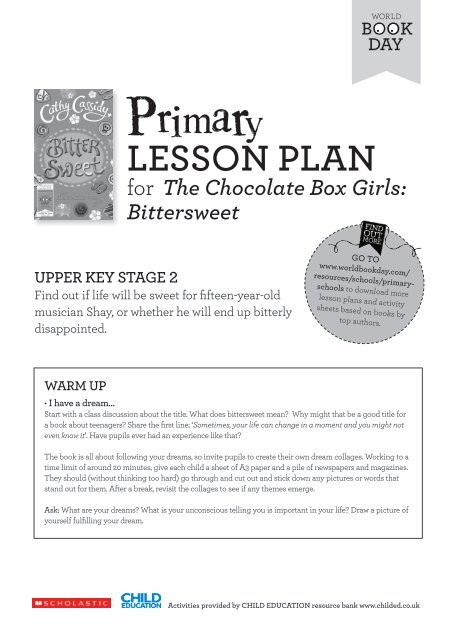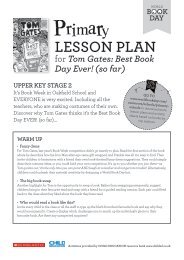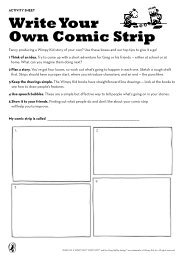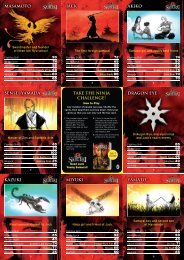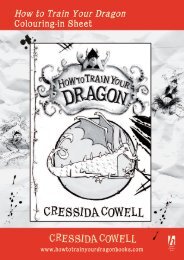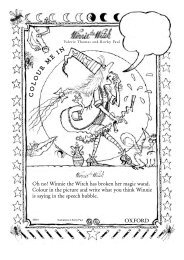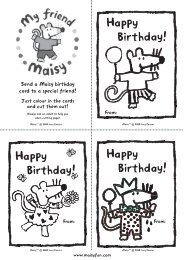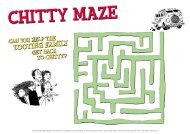LESSON PLAN - World Book Day
LESSON PLAN - World Book Day
LESSON PLAN - World Book Day
You also want an ePaper? Increase the reach of your titles
YUMPU automatically turns print PDFs into web optimized ePapers that Google loves.
MAIN ACTIVITIES• Decisions, decisionsShay is faced with some difficult dilemmas at several points in the book. You could use drama to explorehis options, predict the possible outcomes, and as a starting point for writing.1. Read up to ‘they’re going to love you’ on page 3. Choose pupils to be Shay in two possible scenarios, andget the rest of the class to interview him:Scenario 1: Shay has just signed to Wrecked Rekords and is on the brink of fame and fortune.Scenario 2: Shay has stayed on at school, but still dreams of being a star.2. Read up to ‘call her back later’ on page 21. Set up a ‘conscience corridor’ in the class, with the childrenin two lines facing each other. Ask those on one side to pretend they think Shay should answer Cherry’scall. Ask those on the other side to pretend they believe he should ignore the call and listen to Honey. Askchildren to take turns to be Shay and to walk slowly between the lines, listening to the rest of the classtrying to persuade him to their point of view.3. Read up to ‘perhaps I’d get spotted too…’ on page 24. Ask children to write a journal as Shay, but theymust decide whether he has run away to London with Honey or stayed behind in Somerset. Share thedifferent journals entries, before reading on to see what he does do next.• True or false?Once you’ve read the book together, challenge children to work in pairs to create a ‘true or false’ multiplechoicequiz based on the story. The best ones could be shared with the author, Cathy Cassidy, via herwebsite, www.cathycassidy.com, which has lots of competitions, downloads and activities that fans of thebooks will enjoy.EXTENSION ACTIVITIES• First things firstAs we have seen, the first line in Bittersweet neatly sums up what the story is all about. Provide a selectionof books by well-known authors and get pupils to write down the opening lines, then share them withthe class. Which ones make you want to read on? Why? Instead, pupils could choose one of the openingsfrom the activity sheet First Lines and use it as the starting point for their own story writing.Activities provided by CHILD EDUCATION resource bank www.childed.co.uk
• Whose line is it anyway?Bittersweet is part of Cathy Cassidy’s Chocolate Box Girls series, in which each story is told by a differentcharacter. Pupils could rewrite Bittersweet, or part of it, from another’s point of view—for example, Shay’smum or dad, Honey, Ben or Curtis.• Chocs away!Cherry Crush, the first book in Cathy’s Chocolate Box Girls series, includes two yummy chocolate recipes.Why not create a class chocolate recipe book with each pupil contributing their favourite chocolate dish.You could even hold a chocolate-themed bake-off.PLENARYAs Cathy Cassidy points out in her introduction, Shay’s life is ticking over pretty nicely at the start of thebook, but then it all falls apart. Discuss what life lessons pupils think Shay learnt as the story went on.What about Honey and Cherry? Ask pupils to imagine themselves as an adult Shay. What advice do youthink he would give his younger self?FURTHER READING• Glitter by Kate Maryon (harper collins)• Cassie’s Crush by Fiona Foden (scholastic)• Jane Austen Stole My Boyfriend by Cora Harrison (macmillan)• The Twice-lived Summer of Bluebell Jones by Susie <strong>Day</strong> (scholastic)• Lemonade Sky by Jean Ure (harper collins)• Cathy Cassidy’s website: www.cathycassidy.comActivities provided by CHILD EDUCATION resource bank www.childed.co.uk
ACTIVITY SHEETfor The Chocolate BoxGirls: BittersweetFIRST LINESWhich of these first lines make you want to read on? Why?“When the doorbell rings at three in the morning, it’s never good news.”Stormbreaker by Anthony Horowitz“There is no lake atCamp Green Lake.”Holes by Louis Sachar“Mr and Mrs Dursley, of number four, PrivetDrive, were proud to say that they wereperfectly normal, thank you very much.”Harry Potter and the Philosopher’s Stone by J.K. Rowling“The Iron Mancame to the topof the cliff.”The Iron Manby Ted Hughes“I once met a girlwith rainbowglasses.”Bad Girls by Jacqueline Wilson“‘Honestly, Mrs Hadley,’ said MeggieMcGregor, wiping her eyes. ‘That sense ofhumour of yours will be the death of me yet!’”Noughts and Crosses by Malorie Blackman“A thousand miles ago, in a country east ofthe jungle and south of the mountains, therelived a Firework-Maker called Lalchand andhis daughter Lila.”The Firework Maker’s Daughter by Philip Pullman“How does one describe Artemis Fowl?Various psychiatrists have tried and failed.”Artemis Fowl by Eoin Colfer“If, standing alone onthe back doorstep,Tom allowed himselfto weep tears, theywere tears of anger.”Tom’s Midnight Gardenby Philippa Pearce“What sort of bookis this?”Endymion Spring by Matthew Skelton“My earliest memories are a confusion of hillyfields and dark, damp stables, and rats thatscampered along the beams above my head.”War Horse by Michael Morpurgo“My best friend, Tracy Wu, saysI’m really tough on people.”Blubber by Judy BlumeActivities provided by CHILD EDUCATION resource bank www.childed.co.uk
CURRICULUM LINKS (National Curriculum KS2)ENGLISHEN 1 (Speakingand Listening)EN 2 (Reading)EN3 (Writing)3. To talk effectively as members of agroup, pupils should be taught to:a. make contributions relevant to thetopic and take turns in discussionc. qualify or justify what they thinkafter listening to others’ questions oraccounts4. To participate in a wide range ofdrama activities and to evaluate theirown and others’ contributions, pupilsshould be taught to:a. create, adapt and sustain differentroles, individually and in groupsc. use dramatic techniques to explorecharacters and issues (for example, hotseating, flashback)11. The range should include:a. improvisation and working in role3. Pupils should be taught to:c. obtain specific information throughdetailed reading4. To develop understanding andappreciation of literary texts, pupilsshould be taught to:c. identify how character and settingare created, and how plot, narrativestructure and themes are developede. evaluate ideas and themes thatbroaden perspectives and extendthinkingh. respond imaginatively, drawing onthe whole text and other reading1. Pupils should be taught to:c. use language and style that areappropriate to the readerd. use and adapt the features of a formof writing, drawing on their reading9. The range of purposes for writingshould include:a. to imagine and explore feelingsand ideas, focusing on creative usesof language and how to interest thereaderActivities provided by CHILD EDUCATION resource bank www.childed.co.uk


